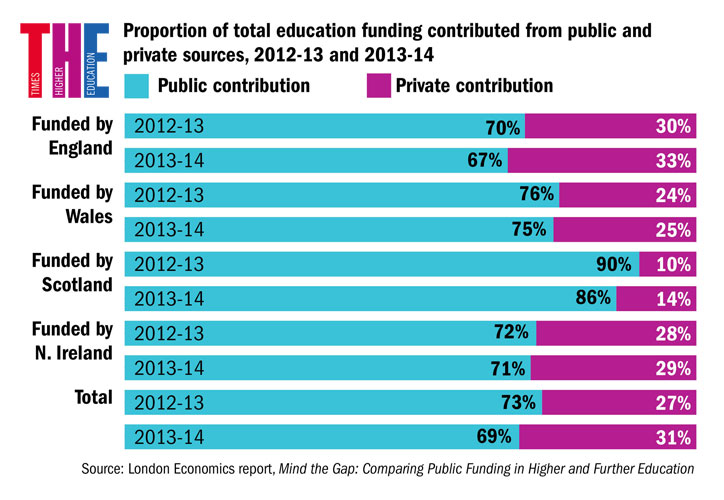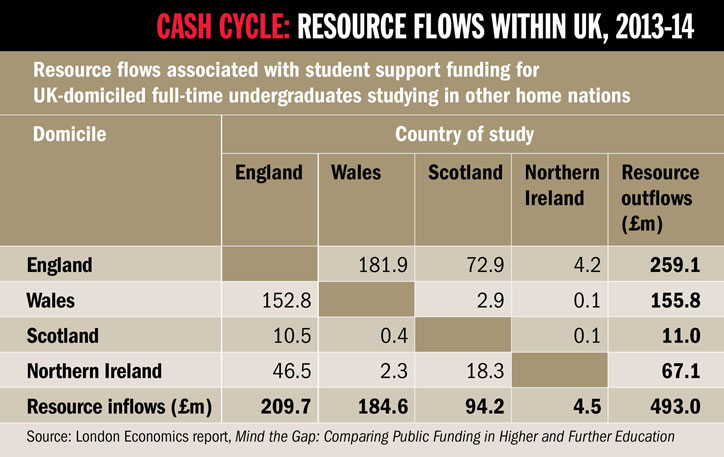Where a student lives in the UK, and where they choose to study, has never had a bigger impact on how much their higher education costs.
This applies to individuals, but it also applies to governments. New research, published by the University and College Union on 19 November, sets out in detail how devolution has resulted in widespread variation in the amount of money that administrations in different parts of the UK spend on higher education, per student.
The analysis, by consultancy London Economics, also demonstrates that governments cannot afford to ignore their neighbours’ policies, despite devolution.
This is because of student mobility, which meant that nearly £500 million of student support funding crossed borders within the UK in 2013-14 alone. Some nations are enjoying large “inflows”, while others are paying out significantly more than comes their way.
The report, Mind the Gap: Comparing Public Funding in Higher and Further Education, calculates that, across the UK as a whole, governments paid for 69 per cent of the cost of educating students in 2013-14 – paying in some £13 billion.
This covered block grants to institutions, including quality-related research funding, student support such as grants and targeted funding including Disabled Students’ Allowances, as well as student loans – on the assumption that some of the money that is borrowed will never be paid back.
The remaining 31 per cent was paid for out of students’ own pockets, or other private sources.
But there was widespread variation across different nations, with Scotland, where tuition remains free for home-domiciled students, funding 86 per cent of the cost of students’ education using public funds in 2013-14.
England, in the second year of allowing its universities to charge up to £9,000 annually, paid for 67 per cent of students’ education with public funds.
Wales and Northern Ireland, which required home-domiciled students to contribute about £3,685 and £3,575 annually to the cost of their education in 2013-14, paid for 75 per cent and 71 per cent, respectively.
When considered on a per student basis, average total funding (public and private) per student was highest for English students studying in their home nation, at £13,983 in 2013-14, and was lowest for Scottish students studying in Scotland, at £11,310.
But, when public funding alone is considered, and when loan repayment rates are taken into account, Scotland performed much better, spending an average of £9,016 per home learner.
Wales led the way, on £9,456, with England on £8,870 and Northern Ireland well behind on £7,721.
The gaps are growing: from 2012-13 to 2013-14, there was a 9.5 per cent rise in funding per home student in Wales and only a 1.4 per cent increase in Northern Ireland. Funding increased by 5.1 per cent and 3.7 per cent in Scotland and England respectively.
Gavan Conlon, leader of the education team at London Economics, said that just two years of data for the higher fees era revealed “four highly complex national systems within which substantial funding gaps are already emerging”, and that these trends would continue.
Dr Conlon said that the means by which the bulk of public funding is disbursed was also significant. This is because funding that is given directly to institutions stays within a nation’s borders, while funding that comes via the student tends to be portable.
Again, there is significant variation between administrations. In Scotland, 63 per cent of funding per full-time, home-domiciled undergraduate was paid to institutions via the Scottish Funding Council in 2013-14.
In contrast, and taking account of expected loan repayment rates, 68 per cent of funding was distributed as student support in England that year, up from 61 per cent in 2012-13.
In Wales, which provided fee grants of up to £5,315 to students in 2013-14, 81 per cent of public funding went via the student; while, in Northern Ireland, the funding mix was more even, with 46 per cent being distributed as student support and 54 per cent going directly to institutions.
The result was that, although Scottish students studying in England are eligible to apply for student loans from their government, an average of only £2,227 of student support funding followed each student over the border in 2013-14, the report says. Perhaps unsurprisingly, given the free tuition on offer in Scotland, only 5 per cent of Scottish-domiciled students chose to study in England that year.
In contrast, given the portability of Welsh student finance across borders, learners who chose to study elsewhere in the UK took more than £7,000 of student support with them, on average, the report says. Some 26 per cent of Welsh students studied in England in 2013-14.
Both English and Northern Irish students took between £5,000 and £6,000 across borders with them if they studied elsewhere in the UK. Only 4 per cent of English students did this, but 15 per cent of Northern Irish students studied in England in 2013-14.
London Economics has calculated that, as a result, only £11 million of Scottish student support funding was channelled to students in other home nations in 2013-14, while £94.2 million came into the country from elsewhere in the UK.
In contrast, Northern Ireland saw £67.1 million of funding go across the Irish Sea and received only £4.5 million in return.
The most porous border is between England and Wales, with the amount of Welsh money going to students at English universities being a particular concern for some Welsh vice-chancellors.
The report says that £155.8 million of Welsh student support went to students in the rest of the UK, but finds that this is outweighed by the £184.6 million that it received in return.
In fact, it is England that loses out. Some £259.1 million of student support went to English students studying elsewhere in the UK in 2013-14, but only £209.7 million came into the country.
Dr Conlon said that the cross-border flows “may or may not be problematic”, depending on your perspective.
“Fundamentally, human capital is one of the biggest sources of economic growth, so it is good from an economic perspective to fund higher education adequately to meet the needs of the populations in question,” he said. “But there is an issue about whether sufficient funding is being allocated to higher education institutions, especially in a period when there is going to be a reduction in the level of spending from central government.”
后记
Print headline: Bringing money over the border






